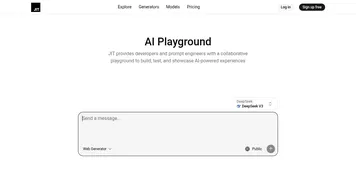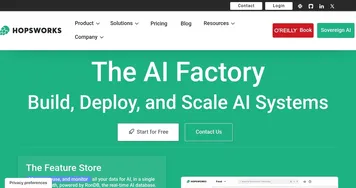Mage AI
Mage AI is an open-source data pipeline tool designed for transforming and integrating data, offering a notebook-style interface for building, running, and managing workflows. It supports Python, SQL, and R, allowing data engineers to create real-time and batch pipelines with modular code blocks. The platform integrates with over 100 third-party sources, including databases, APIs, and cloud storage, streamlining ETL processes. Mage AI positions itself as a modern alternative to Apache Airflow, emphasizing a simpler developer experience and built-in data validation.
Key features include a visual pipeline editor, data-aware autocomplete, and AI-assisted coding that suggests optimizations and debugs issues. The hyper-concurrency engine dynamically scales workloads, reducing costs by up to 40% compared to traditional setups. Users can schedule pipelines via cron or trigger them through events, APIs, or webhooks. The open-source version is self-hosted, requiring tools like Docker or conda, while Mage Pro offers enterprise-grade orchestration and collaboration tools.
Compared to competitors like Prefect and Dagster, Mage AI excels in its low learning curve and developer-friendly interface. Prefect offers robust streaming capabilities, but its setup can be heavier. Dagster focuses on data assets, which may suit teams prioritizing lineage over pipeline flexibility. Mage’s notebook UI, however, can occasionally fail to save changes, frustrating users. Its community, while active on Slack, is smaller than Airflow’s, limiting peer support.
Mage AI’s pricing for the Pro version is flexible, aimed at scaling teams, but lacks transparent details compared to Prefect’s clear tiers. The open-source version is free, ideal for small teams or testing. Unexpectedly, Mage’s dynamic runtime settings allow one pipeline to handle multiple configurations, boosting efficiency for varied datasets.
To get started, deploy Mage locally using Docker for a cost-free trial. Explore the interactive demo on their site to understand the UI. Leverage the Slack community for quick support, and use prebuilt templates to accelerate pipeline development. Regularly save work to avoid UI glitches.
Video Overview ▶️
What are the key features? ⭐
- Data Loader: Extracts and syncs data from 100+ third-party sources.
- Transformer Blocks: Transforms data using Python, SQL, or R in reusable code blocks.
- Hyper-Concurrency Engine: Scales workloads dynamically for efficient processing.
- Data-Aware Autocomplete: Suggests code based on upstream data and context.
- Visual Pipeline Editor: Provides real-time previews and drag-and-drop pipeline building.
Who is it for? 🤔
Examples of what you can use it for 💭
- Data Engineer: Builds real-time ETL pipelines to sync CRM data with a data warehouse.
- Data Scientist: Creates batch pipelines to preprocess datasets for machine learning models.
- Startup Analyst: Automates reporting by moving data from APIs to Google Sheets.
- DevOps Engineer: Schedules pipelines to trigger based on events like API updates.
- Business Intelligence Team: Integrates third-party data for unified analytics dashboards.
Pros & Cons ⚖️
- Free open-source version
- Supports Python, SQL, R
- AI-driven code assistance
- UI can lose unsaved changes
- Smaller community than Airflow
FAQs 💬
Related tools ↙️
-
 JIT.dev
An AI-powered tool that transforms your text inputs into code
JIT.dev
An AI-powered tool that transforms your text inputs into code
-
 CodeGuide
Generates detailed project documentation for AI coding projects, streamlining development
CodeGuide
Generates detailed project documentation for AI coding projects, streamlining development
-
 Factory
Automates software development tasks with AI-driven Droids for coding, testing, and documentation
Factory
Automates software development tasks with AI-driven Droids for coding, testing, and documentation
-
 Hopsworks
Streamlines AI development with a scalable feature store and MLOps platform
Hopsworks
Streamlines AI development with a scalable feature store and MLOps platform
-
 Hexomatic
Automates web scraping and tasks with no-code solutions
Hexomatic
Automates web scraping and tasks with no-code solutions
-
 BlackBox AI
Helps programmers "code as fast as they think"
BlackBox AI
Helps programmers "code as fast as they think"

